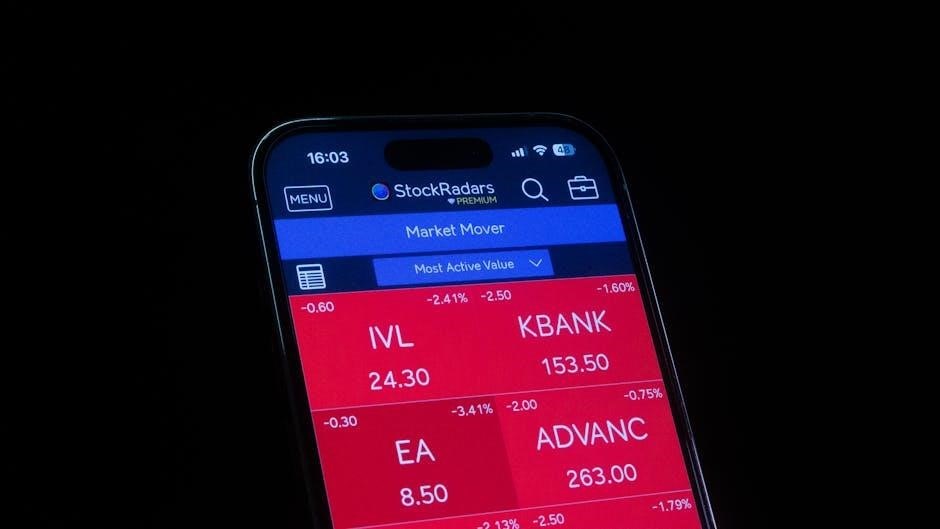
place value chart to millions pdf
A place value chart is a visual tool that helps students understand the positional value of digits in numbers, from units to millions. It organizes numbers by place value, making it easier to identify and work with each digit’s position. This chart is essential for teaching base-ten concepts and is widely used in education. The chart typically includes columns for millions, hundred thousands, ten thousands, thousands, hundreds, tens, and units, providing a clear structure for breaking down numbers. It is a foundational resource for math education, available as free PDF downloads for easy access and printing.
1.1 What is a Place Value Chart?
A place value chart is a visual tool designed to help students understand the positional value of digits in numbers, extending up to millions. It organizes numbers into columns representing different place values, such as millions, hundred thousands, ten thousands, thousands, hundreds, tens, and units. This chart allows users to break down numbers systematically, making it easier to identify and work with each digit’s specific value. Widely used in education, place value charts are available as downloadable PDFs, offering a clear and organized way to teach and learn mathematical concepts related to number systems, operations, and problem-solving.
1.2 Importance of Understanding Place Value
Understanding place value is fundamental to grasping the base-ten number system, which underpins all mathematical operations. It enables students to recognize the value of each digit within a number, such as distinguishing between tens, hundreds, and thousands. This concept is crucial for performing arithmetic operations like addition, subtraction, and multiplication accurately. Place value charts are particularly effective because they provide a visual representation of number positions, making abstract concepts tangible. Without a solid understanding of place value, students may struggle with mental math, rounding, and solving real-world problems. Moreover, place value charts to millions pdf offer a structured way to teach these concepts, ensuring students can break down and analyze numbers systematically. This foundation is essential for advanced math skills and lifelong problem-solving abilities.
Structure of a Place Value Chart
A place value chart to millions pdf is organized into columns, starting from millions and progressing down to units. Each column represents a specific place value, such as millions, hundred thousands, ten thousands, thousands, hundreds, tens, and units. This hierarchical structure helps students visually understand how numbers are composed and the significance of each digit’s position. The chart is a valuable educational tool for teaching place value concepts, allowing learners to break down numbers systematically and identify the value of each digit within a number.
2.1 From Millions to Units
A place value chart to millions pdf is structured to represent numbers from the largest place value (millions) down to the smallest (units). The chart typically includes columns for millions, hundred thousands, ten thousands, thousands, hundreds, tens, and units. Each column represents a specific place value, helping students visualize the hierarchy of numbers. For example, in the number 1,234,567, the digits are organized into their respective places: 1 million, 2 hundred thousands, 3 ten thousands, 4 thousands, 5 hundreds, 6 tens, and 7 units. This clear progression from millions to units makes it easier for learners to break down and understand large numbers systematically. The chart’s design emphasizes the base-ten system, where each place value is a power of ten, providing a foundational understanding of number composition.
2.2 Understanding Each Place Value
Understanding each place value is crucial for grasping the base-ten number system. Starting from millions, each position represents a specific value: millions, hundred thousands, ten thousands, thousands, hundreds, tens, and units. For example, in the number 1,234,567, the ‘1’ represents 1 million, ‘2’ represents 200,000, ‘3’ represents 30,000, ‘4’ represents 4,000, ‘5’ represents 500, ‘6’ represents 60, and ‘7’ represents 7 units. Each digit’s position determines its value, emphasizing the importance of place value in number composition. This hierarchical structure helps students recognize how numbers are built and how each digit contributes to the overall value, making arithmetic operations like addition and subtraction more manageable. Understanding each place value is foundational for advanced math concepts and real-world applications.

How to Use the Place Value Chart
Identify the digit’s position on the chart, then determine its value based on its place, such as millions, thousands, or units. This helps in breaking down numbers systematically.
3.1 Reading Numbers on the Chart
Reading numbers on a place value chart involves identifying each digit’s position and understanding its value. Start from the rightmost digit, which represents units, and move leftward through tens, hundreds, thousands, and millions. Each column on the chart corresponds to a specific place value, allowing students to visually break down numbers. For example, in the number 5,432,1, the digits 5, 4, 3, 2, and 1 are placed under millions, hundred thousands, ten thousands, thousands, and units, respectively. This method ensures clarity and accuracy, especially for large numbers. Using the chart, students can easily convert digits into their respective place values, enhancing their understanding of the base-ten system.
3.2 Teaching Strategies for Effective Use
Effective use of place value charts in teaching involves engaging, interactive strategies. Start by introducing the chart with whole-class instruction, demonstrating how to identify each digit’s value. Use manipulatives like place value disks to reinforce concepts. Incorporate real-life examples, such as money or measurement, to illustrate practical applications. Encourage students to work in pairs or small groups to practice reading and building numbers on the chart. Provide guided practice with worksheets or online tools, then transition to independent activities. For diverse learners, offer differentiated resources, such as enlarged charts for visual learners or digital versions for tech-savvy students. Regularly assess understanding through quizzes and discussions to ensure mastery. Align activities with educational standards for a comprehensive learning experience.
3.3 Rounding Numbers with the Chart
Place value charts are invaluable for teaching rounding numbers. By highlighting the digit to be rounded and the next digit to the right, students can easily determine whether to round up or down. For example, rounding 645 to the nearest hundred involves looking at the tens place (4), deciding to round down, resulting in 600. This visual method builds understanding of estimation and number magnitude. The chart also helps students identify the nearest ten, hundred, or thousand, making rounding a straightforward process. Available as downloadable PDFs, these charts are printable and easy to use in classrooms or at home, providing a practical tool for mastering rounding skills. They align with educational standards and support diverse learners by offering clear, structured guidance.

Creating a Place Value Chart
Design a place value chart by organizing columns from millions to units. Use free PDF templates for easy customization and printing in A4 or US Letter sizes; Available in formats like PNG and JPG, these charts offer flexibility for digital or physical use, ensuring clarity and structure for teaching place value concepts effectively.
4.1 Designing Your Own Chart
Designing a place value chart involves organizing columns for millions, hundred thousands, ten thousands, thousands, hundreds, tens, and units. Start by labeling each column clearly to ensure understanding. Use a base-ten system structure to align with educational standards. Include visual aids like arrows or colors to highlight the progression from smaller to larger units. For digital charts, tools like Canva or Excel can be used, while physical charts can be hand-drawn or printed from templates. Customize the design to suit your audience, such as using larger fonts for younger students or adding images for engagement. Ensure the chart is visually appealing and easy to follow, making it an effective teaching tool for place value concepts.
4.2 Digital vs. Physical Charts
Digital and physical place value charts offer distinct advantages for teaching and learning. Digital charts, available in formats like PDF, PNG, or JPG, provide flexibility and convenience. They can be easily shared, projected in classrooms, and accessed on devices. Tools like Canva or Google Slides allow customization, making them ideal for interactive lessons. Physical charts, printed on paper or poster boards, offer tactile benefits, especially for hands-on learners. They can be displayed in classrooms for constant reference and are useful for group activities. Both formats support visual learning, but digital charts are more versatile, while physical charts provide a traditional, engaging experience. Teachers can choose based on classroom needs, ensuring students grasp place value concepts effectively.

The Importance of Place Value
Understanding place value is foundational for math skills, enabling students to break down numbers, perform operations, and grasp real-world applications like money and measurements. It builds a strong numerical understanding, essential for advanced concepts and problem-solving.
5.1 Link to Real-Life Applications
Place value charts connect abstract math concepts to real-life scenarios, such as budgeting, shopping, and financial planning. Understanding place value helps in calculating totals, making change, and estimating quantities. For instance, when balancing a checkbook or measuring ingredients while cooking, recognizing the value of each digit ensures accuracy. In professions like engineering and architecture, precise number interpretation is crucial. Place value charts also aid in teaching money management, where understanding the difference between, say, thousands and hundreds is vital. This practical application reinforces learning and prepares students for everyday tasks and career challenges, making math relevant and useful beyond the classroom.

Assessing Understanding
Assessing understanding involves both formative and summative methods, such as classwork, quizzes, and projects, ensuring students can apply place value concepts accurately. This helps identify areas needing additional support.
6.1 Quizzes and Activities
Quizzes and activities are essential for assessing students’ understanding of place value concepts. Interactive quizzes can be used to evaluate their ability to identify and apply place values accurately. Printable worksheets, such as those available in PDF format, provide structured exercises for practice. Hands-on activities, like placing number cards on a place value chart, reinforce learning. Teachers can also use games or group tasks to make assessment engaging. These tools help identify gaps in knowledge and ensure students grasp the fundamentals before moving to more complex concepts. Regular assessments with quizzes and activities ensure a comprehensive understanding of place value, making it easier to address any misconceptions early on. This approach supports both individual and classroom-wide progress tracking.

Common Core State Standards
Place value charts align with Common Core State Standards, emphasizing understanding of base-ten concepts. They help students meet standards by visually organizing numbers up to millions, ensuring clarity and precision in math education.
7.1 Alignment with Educational Frameworks
Place value charts are intricately aligned with educational frameworks like the Common Core State Standards, which emphasize a deep understanding of the base-ten number system. These charts provide a visual representation of place values, from units to millions, allowing students to grasp foundational math concepts. By organizing numbers into columns such as millions, hundred thousands, ten thousands, thousands, hundreds, tens, and units, the charts support the structured approach recommended by educational standards. This alignment ensures that students develop a robust understanding of place value, which is critical for performing arithmetic operations and solving real-world problems. The charts are particularly effective for meeting standards related to whole number operations and multi-digit computations, making them a valuable resource for educators and learners alike. Additionally, the availability of these charts in PDF formats facilitates easy integration into classroom curricula, further enhancing their educational utility. Through this structured approach, place value charts not only meet but exceed the expectations set by educational frameworks, providing a comprehensive tool for math education.
Benefits for Diverse Learners
Place value charts benefit diverse learners by providing a clear, visual structure that supports understanding for ELLs and students with special needs.
Their customizable format allows teachers to tailor instruction, ensuring each student can engage with the material at their own pace and learning level.
8.1 Supporting ELLs and Special Needs
Place value charts are invaluable for supporting English Language Learners (ELLs) and students with special needs. Their visual structure simplifies complex concepts, making it easier for these learners to grasp place value relationships. For ELLs, the chart provides a clear, universal language of numbers, reducing linguistic barriers. For students with special needs, the chart offers a predictable and organized format, aiding those with cognitive or learning challenges. Teachers can use the chart to reinforce vocabulary and concepts through repetition and visual cues. Additionally, the chart’s hands-on nature allows for manipulative activities, which can be tailored to meet individual learning needs. This makes it an essential tool for creating an inclusive and effective learning environment.

Using Charts for Operations
Place value charts enhance addition and subtraction by organizing numbers by their place values, making calculations systematic and reducing errors through clear regrouping of digits.
9.1 Addition and Subtraction
Place value charts are invaluable for performing addition and subtraction, as they visually organize numbers by their place values, ensuring proper alignment of digits. This systematic approach minimizes errors during calculations, especially when dealing with large numbers. For instance, when adding or subtracting numbers in the millions, the chart helps students recognize and regroup digits correctly. By breaking down numbers into their constituent parts, students can better understand how values carry over or borrow during operations. This tool is particularly effective for teaching regrouping in subtraction and carrying over in addition, making complex computations more manageable. The chart also serves as a visual aid to explain concepts like borrowing and carrying, reinforcing the base-ten number system and preparing students for more advanced arithmetic.
- Organizes numbers by place value for accurate alignment.
- Facilitates regrouping during addition and subtraction.
- Enhances understanding of borrowing and carrying over.
- Supports mastery of the base-ten system.
- Helps students manage multi-digit computations effectively.

Interactive Activities
Engage students with interactive tasks like matching games, digital tools, and group activities using place value charts. These hands-on exercises make learning fun and effective for understanding millions place value.
10.1 Engaging Students
Engaging students with place value charts involves interactive and hands-on activities that make learning fun and effective. Use group work, where students match numbers to their place values on the chart, fostering collaboration. Incorporate digital tools, such as interactive place value games, to cater to tech-savvy learners. Encourage students to create their own charts or use manipulatives like place value disks to visualize concepts. Integrate real-life examples, such as budgeting or measuring, to connect place value to practical scenarios. Provide immediate feedback through quizzes or competitions to keep students motivated. By incorporating diverse teaching methods, educators can ensure that all learners stay engaged and develop a strong understanding of place value up to millions.

Comparison of Chart Types
Place value charts are available in various formats, including physical, digital, and printable PDF versions. Physical charts offer tactile learning benefits, while digital tools provide interactive features. Printable PDFs are portable and easy to distribute, making them ideal for classroom use. Digital charts often include customizable options, allowing teachers to tailor them to specific lessons. Physical charts, however, can be more engaging for hands-on learners. Both types cater to different learning preferences, ensuring flexibility for educators and students alike.
11.1 Physical vs. Digital Tools
Physical place value charts, such as printed PDF versions, offer a tactile learning experience, making them ideal for hands-on activities. Students can visually track place values and manipulate physical components, enhancing understanding. Digital tools, however, provide interactivity and customization, allowing teachers to adapt charts for specific lessons. Digital charts can be projected in classrooms or accessed online, offering convenience and space-saving benefits. Printable PDFs combine the best of both worlds, enabling easy distribution while retaining the visual clarity of physical charts. Both formats cater to different learning styles, with physical tools suiting tactile learners and digital tools appealing to tech-savvy students. This flexibility ensures educators can choose the most effective medium for their teaching environment.
A place value chart to millions PDF is an invaluable educational tool, simplifying complex number concepts and fostering a deep understanding of positional values in mathematics.
12.1 Summary and Final Thoughts

Additional Resources
Find more information and downloadable place value charts at websites like Math-Drills.com. These resources offer printable PDFs, PNGs, and JPGs in various formats for easy access and use.
13.1 Where to Find More Information
For additional resources on place value charts, visit educational websites like Math-Drills.com, which offer free, downloadable PDF charts for millions to units. These charts are available in multiple formats, including PNG and JPG, making them versatile for printing or digital use. Many websites also provide lesson plans and activities to complement the charts, helping educators create engaging math lessons. Additionally, teacher forums and educational blogs often share creative ways to incorporate place value charts into daily instruction. For those seeking more detailed guides, some platforms offer comprehensive workbooks and video tutorials that align with Common Core standards. These resources are designed to support both teachers and students in mastering place value concepts effectively.
Leave a Reply
You must be logged in to post a comment.